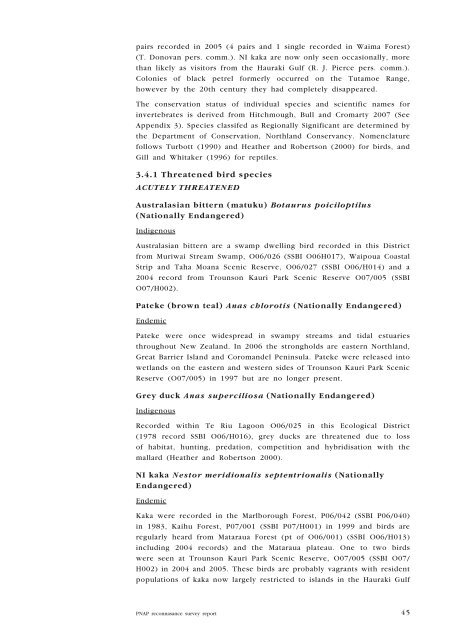Natural areas of Tutamoe Ecological District (3. Ecological character)
Natural areas of Tutamoe Ecological District (3. Ecological character)
Natural areas of Tutamoe Ecological District (3. Ecological character)
You also want an ePaper? Increase the reach of your titles
YUMPU automatically turns print PDFs into web optimized ePapers that Google loves.
pairs recorded in 2005 (4 pairs and 1 single recorded in Waima Forest)<br />
(T. Donovan pers. comm.). NI kaka are now only seen occasionally, more<br />
than likely as visitors from the Hauraki Gulf (R. J. Pierce pers. comm.).<br />
Colonies <strong>of</strong> black petrel formerly occurred on the <strong>Tutamoe</strong> Range,<br />
however by the 20th century they had completely disappeared.<br />
The conservation status <strong>of</strong> individual species and scientific names for<br />
invertebrates is derived from Hitchmough, Bull and Cromarty 2007 (See<br />
Appendix 3). Species classifed as Regionally Significant are determined by<br />
the Department <strong>of</strong> Conservation, Northland Conservancy. Nomenclature<br />
follows Turbott (1990) and Heather and Robertson (2000) for birds, and<br />
Gill and Whitaker (1996) for reptiles.<br />
<strong>3.</strong>4.1 Threatened bird species<br />
Acutely threAtened<br />
Australasian bittern (matuku) Botaurus poiciloptilus<br />
(Nationally Endangered)<br />
Indigenous<br />
Australasian bittern are a swamp dwelling bird recorded in this <strong>District</strong><br />
from Muriwai Stream Swamp, O06/026 (SSBI O06H017), Waipoua Coastal<br />
Strip and Taha Moana Scenic Reserve, O06/027 (SSBI O06/H014) and a<br />
2004 record from Trounson Kauri Park Scenic Reserve O07/005 (SSBI<br />
O07/H002).<br />
Pateke (brown teal) Anas chlorotis (Nationally Endangered)<br />
Endemic<br />
Pateke were once widespread in swampy streams and tidal estuaries<br />
throughout New Zealand. In 2006 the strongholds are eastern Northland,<br />
Great Barrier Island and Coromandel Peninsula. Pateke were released into<br />
wetlands on the eastern and western sides <strong>of</strong> Trounson Kauri Park Scenic<br />
Reserve (O07/005) in 1997 but are no longer present.<br />
Grey duck Anas superciliosa (Nationally Endangered)<br />
Indigenous<br />
Recorded within Te Riu Lagoon O06/025 in this <strong>Ecological</strong> <strong>District</strong><br />
(1978 record SSBI O06/H016), grey ducks are threatened due to loss<br />
<strong>of</strong> habitat, hunting, predation, competition and hybridisation with the<br />
mallard (Heather and Robertson 2000).<br />
NI kaka nestor meridionalis septentrionalis (Nationally<br />
Endangered)<br />
Endemic<br />
Kaka were recorded in the Marlborough Forest, P06/042 (SSBI P06/040)<br />
in 1983, Kaihu Forest, P07/001 (SSBI P07/H001) in 1999 and birds are<br />
regularly heard from Mataraua Forest (pt <strong>of</strong> O06/001) (SSBI O06/H013)<br />
including 2004 records) and the Mataraua plateau. One to two birds<br />
were seen at Trounson Kauri Park Scenic Reserve, O07/005 (SSBI O07/<br />
H002) in 2004 and 2005. These birds are probably vagrants with resident<br />
populations <strong>of</strong> kaka now largely restricted to islands in the Hauraki Gulf<br />
PNAP reconnasance survey report<br />
45

















